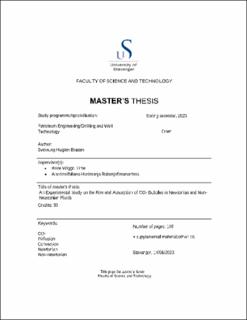| dc.description.abstract | CO2 released from combustion of carbon or hydrocarbons has the potential to be stored in oceans or water based systems. Optimizing this process requires collecting comprehensive data with varying parameters to gain a deeper understanding of the system’s dynamics. With this in mind, this thesis aims to construct a visual model that examines the behavior of CO2 in conjunction with Newtonian and non-Newtonian fluids within closed and open systems. Deionized water combined with NaOH and a pH color-indicator was chosen as the Newtonian fluid, while the non-Newtonian fluid was created by adding HEC (Hydroxyethyl cellulose) at three different concentrations. In the open system, it’s observed that the Newtonian fluid is more efficient in both absorbing and distributing CO2, albeit with a more chaotic flow pattern, due to the high level of
convection. Convection is also heavily present in the runs with non-Newtonian fluid, but the flow patterns and the fluid front follow a more predictable path. There’s also a clearer difference between the CO2 absorbed fluid (yellow fluid) and the non-CO2 absorbed fluid (blue fluid). At the interface between these fluid, shear instability can be observed. The CO2 bubbles flowing through the system has also been investigated. It’s observed that CO2 bubbles in Newtonian fluid deviate more frequently along its axis, but with a more predictable pattern than any deviation in non-Newtonian fluid. The size of the bubbles are also different in the fluids. For all non-Newtonian fluids the bubbles are seen as larger than in Newtonian fluid. For this particular flow rate they also tend to travel together in a chain of bubbles sticking together, and has potential to coalesce into one larger bubble, especially in the fluid containing the highest concentration of HEC. Such coalescence are seen to impact the flow of both the bubble and the surrounding fluid in a greater way. For the Newtonian fluid, no
bubble coalescence or "kissing effect" is observed. However, at lower flow rates, larger bubbles are formed in the Newtonian fluid. These bubbles do experience a larger degree of deformation than the smaller bubbles formed at higher flow rates. Also in the closed setup, in which a volumetric pipette with closed top is lowered into the experimental liquid, we observe that the Newtonian fluid seems to be the most efficient CO2 absorbing liquid. The fluid containing 1.00% HEC show that it has the fastest rise inside the vol.pipette, and the fastest absorption of CO2, but it’s also the one that releases the CO2 the fastest. This could indicate a relation between the rate at which the fluid rises inside the pipette, and the amount of CO2 which temporarily enters the liquid. That being said, the Newtonian fluid was observed to absorb around the same amount of CO2,
but was able to hold an excess of CO2 for a longer period of time. The curve of the pressure data is seen to have a damping-form, in which the CO2 rapidly enters the fluid due to the high difference in gas concentration, before the liquid slowly releases the excess gas above the surface again, leading to an equalization in differential pressure and a reduction in liquid column height. | |
